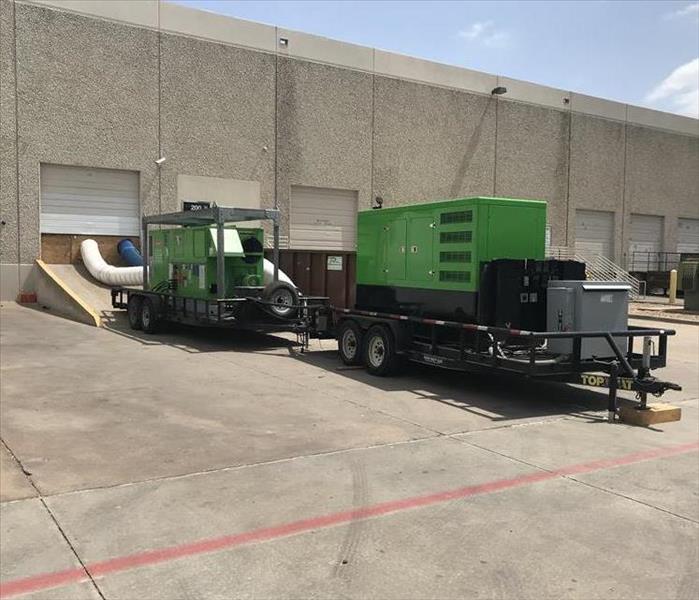What Are Some Subtle Signs of Storm Damage that Can Lead to Flooding in Dallas?
1/28/2022 (Permalink)
 SERVPRO provides trailer-desiccant dehumidifiers for large flood-damaged facilities. We also use small moisture-seeking devices for Dallas residences.
SERVPRO provides trailer-desiccant dehumidifiers for large flood-damaged facilities. We also use small moisture-seeking devices for Dallas residences.
Devices to Ensure Management of All the Ways Flooding Can Damage Your Dallas Home
When you envision flooding issues that could affect your Dallas house, a wall of water pushing its way over the ground and into the lowest levels of your property immediately comes to mind. Water damage certainly can flow in from overland flash flooding or through great holes torn into the roof or siding. Dramatic loss grabs your attention, but the storm damage you do not notice can wreak even more havoc.
How Do You Find Hidden Flood Damage?
The rains pounding on your Dallas home create flood damage in ways you could not expect. If you are far from waterways or your home is at a slight elevation, flash flooding might not pour into your abode. Do not be lulled into a sense of false security as you congratulate yourself on avoiding rising waters. In your home, issues might be confined to falling waters instead. The precipitation and interior pathways that rain finds to percolate down through the building materials forming the structure of your dwelling can result in flooding.
My Walls Are Damp--Is This Just Humidity Because of the Rain or A Severe Problem?
Even if your roof seems intact during the deluge and the high winds that accompany the storm, water has many ways of finding its way into a building. In some cases, you see no puddles of water, but other strange effects appear ominous. SERVPRO answers phone calls during the hours and days after a significant rainstorm, customers describing their observations about walls and ceilings in terms of:
- Sweating
- Bulging
- Cracking
- Staining
- Separating (from crown moldings and baseboards)
What Causes My Walls and Ceilings to Show Unusual Signs of Damage After Heavy Rains?
When we investigate, our managers and technicians realize rain penetrated through aging shingles, loose flashing, and other weaknesses in the roof's decks and joints. One way water can invade in alarming quantities is under the shingles near the gutter system. Rain that totals more than an inch per hour can happen in our region. Massive downpours pool up in the gutters, topping off and pouring over the side into a tsunami that can force itself under the shingles on the edge of the roof. Once inside, the water begins a wandering journey that can soak the back of drywall or lath and plaster, collect over ceilings, rise in building cavities, and eventually form slicks on surfaces and flood floors several stories down from the roof.
How Do Professionals Handle the Hidden Water Safely?
Water trapped in between walls or over ceilings presents significant safety hazards. The weight of just one gallon of water is 8.34 pounds, so if you have dozens to hundreds of gallons of percolated rainwater filling building cavities, a dangerous collapse can be imminent. Our employees master the rigorous coursework developed by the Institute of Inspection Cleaning and Restoration Certification (IICRC), including what to look for and how to manage these trapped water safety concerns.
Steps to find the water include:
- Wearing of appropriate protective equipment, including hard hats
- Visual review of the affected area and surfaces
- Deployment of moisture detection and metering tools to locate and measure moisture levels
- Use of thermal imaging cameras and evaluation of temperature fluctuations to isolate caches of water
Steps to manage the water load include:
- Careful punching of weep holes in blistered paint and ceilings
- Prying off of baseboards to cut or drill release holes
- Use of saws to make "flood cuts" to release water, remove damaged wallboard, and open wet spaces for structural drying
Why Is Water Rising in my Basement Without Flash Flooding?
If your roof stood up to the heavy rain and no overland flooding is apparent, why is water rising in your lowest levels? Rain that "trains" over several hours or days, one downpour following another, causes the ground around your home to saturate thoroughly. The pressure of the water needs a release, plus it is a scientifically proven fact that wet goes to dry. The brick, cinder block, concrete, or other types of the foundation is permeable under certain conditions, especially when the ground can hold no more. Seepage shows up inch by inch inside the perimeter of the foundation. Cinder blocks pose a unique problem because the stormwater can collect in the cells as well as ooze into your basement.
We look beyond the obvious to make sure SERVPRO of Northwest Dallas resolves all your flooding concerns after extreme weather patterns bring torrential rains. Waste no time and call (214) 361-7887 for a proactive assessment and recovery plan.





 24/7 Emergency Service
24/7 Emergency Service